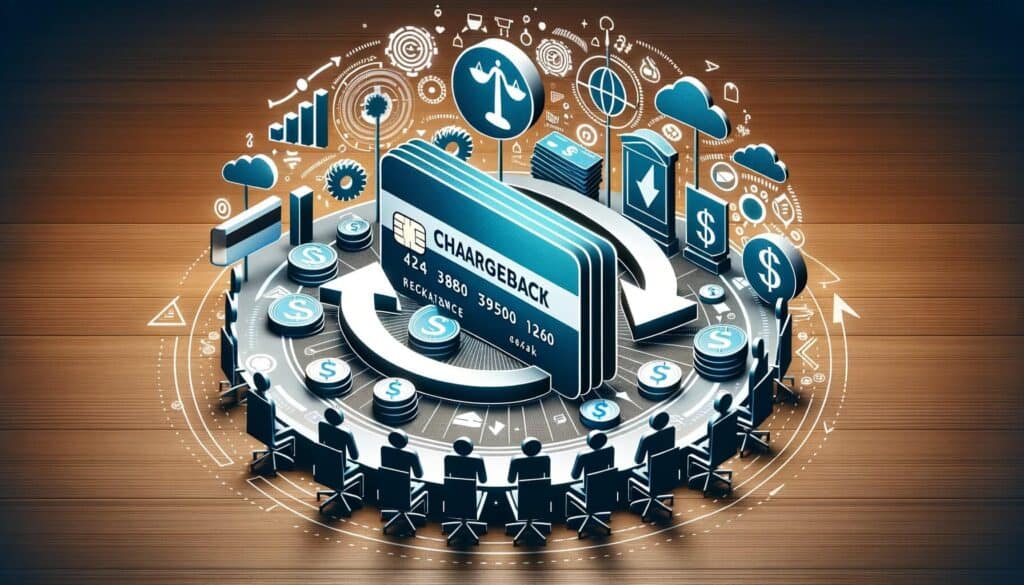
By Barbara Thomas March 11, 2025
In today’s digital age, chargebacks have become a common occurrence in the world of business. Whether you are a small online retailer or a large multinational corporation, understanding chargebacks is crucial for maintaining a healthy financial ecosystem.
In this comprehensive guide, we will delve into the definition of chargebacks, the chargeback process, common reasons for chargebacks, how to dispute them, strategies for chargeback reversal, tools and services for chargeback management, chargeback fraud prevention, and a real-life case study.
By the end of this article, you will have a thorough understanding of chargebacks and be equipped with the knowledge to navigate this complex landscape.
The Chargeback Process: Step-by-Step Guide
The chargeback process can be overwhelming for businesses, especially those who are unfamiliar with its intricacies. To help you navigate this process, we have broken it down into a step-by-step guide.
Step 1: Initiation – The chargeback process begins when a customer disputes a transaction with their issuing bank. This can be due to various reasons such as fraud, dissatisfaction with the product or service, or unauthorized use of their card.
Step 2: Investigation – Once the dispute is initiated, the issuing bank will investigate the claim. They will gather evidence from both the customer and the merchant to determine the validity of the chargeback.
Step 3: Provisional Credit – During the investigation, the issuing bank may provide the customer with a provisional credit. This means that the customer will receive a refund for the disputed amount while the investigation is ongoing.
Step 4: Merchant Response – As a merchant, you have the opportunity to respond to the chargeback. This involves providing evidence to support your case and refute the customer’s claim.
Step 5: Arbitration – If the issuing bank is unable to reach a resolution based on the evidence provided, the case may proceed to arbitration. This involves a third-party mediator who will review the evidence and make a final decision.
Step 6: Resolution – Once a decision is reached, the issuing bank will notify both the customer and the merchant of the outcome. If the chargeback is upheld, the merchant will be required to refund the disputed amount. If the chargeback is overturned, the customer will lose the provisional credit and be responsible for the payment.
Common Reasons for Chargebacks and How to Prevent Them

Chargebacks can occur for a variety of reasons, and understanding these reasons is crucial for preventing them. Here are some common reasons for chargebacks and strategies to prevent them:
1. Fraudulent Transactions – One of the most common reasons for chargebacks is fraudulent transactions. To prevent this, merchants should implement robust fraud detection systems and require additional verification for high-risk transactions.
2. Dissatisfaction with Product or Service – Customers may initiate chargebacks if they are dissatisfied with the product or service they received. To prevent this, merchants should focus on providing excellent customer service, resolving complaints promptly, and offering refunds or exchanges when necessary.
3. Unauthorized Use of Card – Chargebacks can also occur when a customer’s card is used without their authorization. Merchants can prevent this by implementing strict security measures, such as requiring CVV verification and two-factor authentication.
4. Processing Errors – Processing errors, such as duplicate charges or incorrect amounts, can lead to chargebacks. Merchants should ensure that their payment systems are functioning properly and regularly reconcile their transactions to identify any errors.
5. Subscription Cancellations – Chargebacks can occur when customers forget to cancel their subscriptions and are subsequently billed. Merchants should make it easy for customers to cancel their subscriptions and provide clear communication about billing cycles.
How to Dispute a Chargeback: A Comprehensive Guide

Disputing a chargeback is an essential step for merchants who believe that the chargeback is unjustified. Here is a comprehensive guide on how to dispute a chargeback effectively:
1. Gather Evidence – The first step in disputing a chargeback is to gather all relevant evidence to support your case. This may include order details, shipping information, customer communication, and any other documentation that proves the validity of the transaction.
2. Review Chargeback Reason Codes – Chargebacks are typically accompanied by reason codes that provide insight into the customer’s claim. Understanding these reason codes will help you craft a compelling response.
3. Craft a Detailed Response – Your response should address each reason code and provide a detailed explanation of why the chargeback is unjustified. Include all relevant evidence and be concise yet persuasive in your arguments.
4. Submit the Response – Once your response is ready, submit it to the appropriate entity, whether it is the issuing bank or a chargeback management platform. Ensure that you meet all deadlines and follow the specified submission process.
5. Follow Up – After submitting your response, follow up with the relevant parties to ensure that your case is being reviewed. Be proactive in providing any additional information that may be requested.
Chargeback Reversal: Strategies and Best Practices

Chargeback reversal is the process of overturning a chargeback decision in favor of the merchant. While it can be challenging, there are strategies and best practices that can increase your chances of success. Here are some effective strategies for chargeback reversal:
1. Maintain Detailed Records – Keeping detailed records of all transactions, customer communication, and order details is crucial for chargeback reversal. These records will serve as evidence to support your case.
2. Act Promptly – Time is of the essence when it comes to chargeback reversal. Respond to chargebacks promptly, gather evidence quickly, and submit your response within the specified timeframe.
3. Provide Compelling Evidence – Your evidence should be clear, concise, and compelling. Include order details, shipping information, customer communication, and any other documentation that supports your case.
4. Use Chargeback Representment Services – Chargeback representment services can help you navigate the chargeback reversal process. These services specialize in crafting persuasive responses and gathering evidence to support your case.
5. Monitor Chargeback Ratios – Monitoring your chargeback ratios is crucial for identifying trends and taking proactive measures to prevent chargebacks. Aim to keep your chargeback ratio below the industry average to maintain a healthy financial ecosystem.
Chargeback Management: Tools and Services for Businesses

Managing chargebacks can be a complex and time-consuming task for businesses. Fortunately, there are tools and services available to streamline the process and minimize the impact of chargebacks. Here are some essential tools and services for chargeback management:
1. Chargeback Alerts – Chargeback alert services notify merchants when a customer has initiated a chargeback. This allows merchants to respond promptly and gather evidence to dispute the chargeback.
2. Chargeback Prevention Software – Chargeback prevention software uses advanced algorithms and machine learning to detect and prevent fraudulent transactions. These tools can help merchants identify high-risk transactions and take proactive measures to prevent chargebacks.
3. Chargeback Representment Services – Chargeback representment services specialize in crafting persuasive responses and gathering evidence to dispute chargebacks. These services can save merchants time and increase their chances of chargeback reversal.
4. Chargeback Analytics – Chargeback analytics tools provide merchants with insights into their chargeback data. These tools can help identify trends, pinpoint areas of improvement, and take proactive measures to prevent chargebacks.
5. Chargeback Dispute Resolution Platforms – Chargeback dispute resolution platforms provide a centralized platform for managing chargebacks. These platforms streamline the dispute process, provide templates for responses, and offer analytics to track chargeback performance.
Chargeback Fraud: Types, Warning Signs, and Prevention
Chargeback fraud, also known as friendly fraud, is a significant concern for merchants. It occurs when a customer initiates a chargeback without a valid reason, often with the intention of obtaining a refund while keeping the product or service. Understanding the types of chargeback fraud, warning signs, and prevention strategies is crucial for protecting your business. Here is an overview of chargeback fraud:
Types of Chargeback Fraud:
1. True Fraud – True fraud occurs when a customer’s card is stolen or used without their authorization. The fraudster makes unauthorized purchases, and the legitimate cardholder initiates a chargeback.
2. Friendly Fraud – Friendly fraud occurs when a customer intentionally initiates a chargeback without a valid reason. This can happen due to buyer’s remorse, forgetfulness, or an attempt to obtain a refund while keeping the product or service.
3. Merchant Error – Merchant error chargeback fraud occurs when a merchant makes a mistake, such as double-charging a customer or processing an incorrect amount. The customer initiates a chargeback to rectify the error.
Warning Signs of Chargeback Fraud:
1. Frequent Chargebacks – Customers who frequently initiate chargebacks may be engaging in friendly fraud. Monitor your chargeback ratios and identify customers with a high number of chargebacks.
2. Inconsistent Customer Behavior – Inconsistent customer behavior, such as changing shipping addresses or using different payment methods, can be a warning sign of fraud. Implement fraud detection systems to identify suspicious behavior.
3. Unusual Purchase Patterns – Unusual purchase patterns, such as large orders from new customers or multiple orders with the same billing address but different shipping addresses, can indicate fraud. Implement order verification processes to identify suspicious transactions.
Prevention Strategies for Chargeback Fraud:
1. Implement Fraud Detection Systems – Fraud detection systems use advanced algorithms and machine learning to identify suspicious transactions. These systems can help merchants detect and prevent chargeback fraud.
2. Require Additional Verification – Implement additional verification measures for high-risk transactions, such as requiring CVV verification, two-factor authentication, or address verification.
3. Provide Excellent Customer Service – Providing excellent customer service can help prevent chargebacks due to dissatisfaction. Resolve customer complaints promptly, offer refunds or exchanges when necessary, and communicate clearly with customers.
4. Educate Customers – Educate your customers about the chargeback process and the consequences of friendly fraud. Clearly communicate your refund and return policies to set expectations and reduce the likelihood of chargebacks.
Chargeback Example: A Real-Life Case Study
To illustrate the impact of chargebacks on businesses, let’s examine a real-life case study. ABC Electronics, an online retailer specializing in consumer electronics, experienced a significant increase in chargebacks over a six-month period. Upon investigation, they discovered that a group of customers was engaging in friendly fraud by initiating chargebacks without a valid reason.
ABC Electronics implemented several strategies to address this issue. They started by monitoring their chargeback ratios and identifying customers with a high number of chargebacks. They then reached out to these customers to understand their concerns and resolve any issues. Additionally, ABC Electronics implemented a chargeback prevention software that used advanced algorithms to detect and prevent fraudulent transactions.
As a result of these efforts, ABC Electronics saw a significant reduction in chargebacks and an improvement in their overall financial health. By proactively addressing chargeback fraud and implementing preventive measures, they were able to protect their business and maintain customer satisfaction.
Frequently Asked Questions (FAQs) about Chargebacks
Q1. What is a chargeback?
Answer: A chargeback is a dispute initiated by a customer with their issuing bank to reverse a transaction. It can occur due to various reasons such as fraud, dissatisfaction with the product or service, or unauthorized use of the card.
Q2. How does a chargeback affect businesses?
Answer: Chargebacks can have a significant impact on businesses. They can result in financial losses, damage to reputation, increased processing fees, and potential restrictions or penalties from payment processors.
Q3. Can chargebacks be prevented?
Answer: While chargebacks cannot be completely eliminated, they can be minimized through various preventive measures. These include implementing fraud detection systems, providing excellent customer service, requiring additional verification for high-risk transactions, and educating customers about the chargeback process.
Q4. What is friendly fraud?
Answer: Friendly fraud, also known as chargeback fraud, occurs when a customer initiates a chargeback without a valid reason. This can happen due to buyer’s remorse, forgetfulness, or an attempt to obtain a refund while keeping the product or service.
Q5. How can businesses dispute chargebacks?
Answer: Businesses can dispute chargebacks by gathering evidence to support their case, reviewing chargeback reason codes, crafting a detailed response, submitting the response within the specified timeframe, and following up with the relevant parties.
Conclusion
In conclusion, understanding chargebacks is crucial for businesses of all sizes. By comprehending the definition and overview of chargebacks, the step-by-step process, common reasons for chargebacks, how to dispute them, strategies for chargeback reversal, tools and services for chargeback management, chargeback fraud prevention, and real-life case studies, businesses can navigate this complex landscape and minimize the impact of chargebacks.
By implementing preventive measures, such as fraud detection systems, excellent customer service, additional verification for high-risk transactions, and educating customers about the chargeback process, businesses can reduce the occurrence of chargebacks and protect their financial health.
Chargebacks are an inevitable part of the business world, but with the right knowledge and strategies, businesses can master chargebacks and ensure their long-term success. Stay proactive, monitor chargeback ratios, and continuously improve your processes to maintain a healthy financial ecosystem.